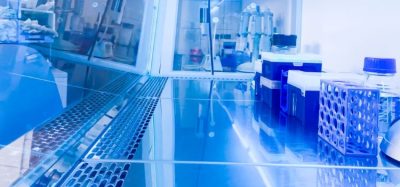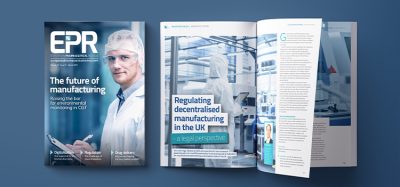Improving the quantitation of live antigens used to produce rabbit generated serotype specific antiserum
Posted: 21 February 2013 |
This is the first paper in our continuing series on Rapid Microbiological Methods (RMM) that will appear in European Pharmaceutical Review during 2013. Flow cytometry represents one of a variety of viability-based RMM technologies that are currently available to the pharmaceutical industry. In flow cytometry, individual particles are counted as they pass through a laser beam in a very narrow flow cell.


To be used in microbiological applications, organisms are pre-labelled with a viability marker or probe, and the labelled cells are injected into the flow cell. Individual cells pass single file through a focused laser beam and are enumerated as the cells fluoresce and light scatter signals are detected. Usually, low levels of test sample volumes are utilised, such as 1 mL or less, because it takes time for this volume to pass through the narrow flow cell. The process of labelling and evaluating viable cells in these types of RMMs can be accomplished in as little as four minutes, and some systems operate automatically with little or no operator intervention or manipulations. Flow cytometry offers a relatively large range of detection operation (10-106 cells/mL) and has been demonstrated to enumerate bacteria, spirochetes, mycoplasmas, parasite cysts, yeasts and mould.
Test methods applicable to the use of flow cytometry include bioburden testing of purified water, liquids and non-filterable material, such as creams and lotions. Other uses include the screening of raw materials, in-process samples and finished product for microbial contamination. In this paper, scientists at MSD have qualified a flow cytometry RMM for the rapid enumeration of bacteria that are used to produce rabbit antiserum. The remainder of this paper summarises the method used and why MSD implemented this novel application.
Case study
MSD is engaged in the production of bacterial vaccines based on several serotypes of Mannheimia haemolytica and Bibersteinia (Pasteurella) trehalosi. Quality control procedures at MSD dictate the need for the quantitation and identification of serotype specific antigens produced before they can be released in a vaccine. A serotype specific antiserum (or polyclonal antibodies) can be used to quantitate and/or identify the presence of a serotype specific antigen through a variety of techniques. This antiserum is produced by injecting rabbits first with inactive and, when needed, later on with live bacterial cells.
Inoculation of an inaccurate amount of live bacteria into rabbits had led to higher morbidity and sometimes even mortality among rabbits as well as the generation of poor quality of antiserum in the past. MSD had been looking to resolve this problem by finding a solution that allowed them to know the viable cell count they were inoculating into the rabbits before actually injecting the bacteria.
They decided to adopt a flow cytometry based rapid method solution for direct and ‘realtime enumeration’ of viable organisms in the bacterial cultures being used for inoculation. The purpose for doing this was two-fold, the first being improvement in the quality of the serotype specific antiserum being used for the quantitation and identification of antigens. The second reason was a conscious decision to follow the guidelines of the National Centre for the Replacement, Refinement and Reduction of Animals in Research (NC3Rs). The goal was to significantly improve animal welfare during and after the generation of the antiserum, by measuring up to the Reduction and Refinement guidelines.
NC3Rs is an independent scientific organisation working with industry, academia, regulators and animal welfare organisations in the UK and internationally to advance the 3Rs:
- Replacement methods can be absolute replacements – techniques which do not involve animals at any point, such as computer modelling, in vitro methodologies (e.g. tissue engineering), or human volunteers – or relative replacements, which avoid or replace the use of ‘protected’ animals
- Reduction refers to methods which minimise animal use and enable researchers to obtain comparable levels of information from fewer animals or to obtain more information from the same number of animals, thereby reducing future use of animals
- Refinement refers to improvements to scientific procedures and husbandry which minimise actual or potential pain, suffering, distress or lasting harm and/or improve animal welfare in situations where the use of animals is unavoidable. It applies to the lifetime experience of the animal.
Background: Ensuring quality control for antigens using antiserum
The method of producing serotype specific antiserum by injecting rabbits with inactive and viable organisms is an established procedure. A paper by J. Fraser et al, published in the Journal of Clinical Microbiology in June 1983, describes how serotype specific antiserum may be created by the inoculation of bacteria into rabbits. A modified version of the indirect haemagglutination test (IHA), performed using Bibersteinia haemolytica, is used to monitor the process of inoculating rabbits to generate antiserum. Bacterial strains used were either from the investigators’ own stock cultures or from field cases referred by the Veterinary Investigation Centre. Rabbits were initially given a dose of killed bacterial cells. The objective of the test is to monitor the sera developed by the rabbits.
Rabbits whose sera did not meet the IHA specifications when injected with multiple rounds of inactive bacteria were injected with two further rounds of live bacteria. The goal was to get a serotype specific titre greater than 1/64, with multiple vaccination rounds with dead cells. Detailed work by the original authors of this piece concluded that live bacterial cultures in the 106 cfu range were needed only if nine injections of killed microorganisms did not provide the desired sera. Injections beyond this were not recommended.
The next step of the process involves quantitating the serotype specific antigen with the antisera produced by the rabbits. A bacterial suspension of the desired serotype was placed in a heated water bath to release the serotype specific antigens. These antigens interact with glutaraldehyde-fixed erythrocytes. Rabbit antisera are added to the sensitised erythrocytes and agglutination is observed, which results in determination, quantification and identification of the serotype specific antigens.
Benefits of adopting a rapid method
MSD previously had to rely on plate count methods to determine what live bacterial load they were injecting into the rabbits. Actual live bacterial loads were always determined after the inoculation had been performed. Instances of rabbit morbidity due to injection of higher live bacterial loads and the generation of poor quality of antiserum were the reasons why MSD reconsidered the processes they were using. They concluded that a ‘real-time’ enumeration of dead and live bacterial cells was needed before injecting these into the rabbits in order to ensure production of the desired quality of antisera.
MSD’s decision to implement a flow cytometry-based rapid method also allowed them to implement two out of the 3Rs of the NC3Rs. By adopting a rapid method that gives them an exact count of the dead or viable bacteria being injected into the rabbit, MSD now knows they are within the inoculation limitations, beyond which the rabbits would experience lasting harm and pain and suffering. This allows their method to be considered a refinement activity.
MSD’s new rapid method is a reduction activity because they have had a 100 percent success record of not having lost any animal since they made the switch to the new method. The benefits derived from the implementation of the rapid method make it an improved experimental design.
MSD Animal Health offers veterinarians, farmers, pet owners and governments the widest range of veterinary pharmaceuticals, vaccines and health management solutions and services. MSD Animal Health is dedicated to preserving and improving the health, well-being and performance of animals. It invests extensively in dynamic and comprehensive R&D resources and a modern, global supply chain. MSD Animal Health is present in more than 50 countries, while its products are available in some 150 markets.
The 3Rs philosophy is widely adopted by MSD Animal Health, for example, the company offers the Dieter Lütticken Award, established in 2004, to promote scientists or life science research institutions working in research areas that serve the 3R-concept, i.e. reducing, refining or replacing the use of animals in testing for development and production of veterinary medicines. In 2005, the NC3Rs awarded a grant to develop in vitro assays to quantify toxin and toxoid levels in Clostridial vaccines.
The group presenting the current case study, the Bioprocess Technology & Support Team is responsible for improvement of existing production processes and test methods. The main focus of the team is supporting the activities of the quality and manufacturing departments. This includes improvement and refinement of current test methods for bacterial antigens and vaccines.
Workflow
Following an overnight incubation, micro – organisms are harvested and quantitated within four minutes using the BD FACSMicroCount. Based on the bacterial count, the cells are diluted to the appropriate levels, which are subsequently used to vaccinate rabbits following a pre-defined protocol (the cell concentration in the vaccines increases from the first to the last vaccination day).
The rapid estimation on cell density of the bacterial suspensions used in rabbit vaccination allows for a more precise and accurate use of appropriate inoculation levels. Additionally, total biomass measurements are more consistent and accurate than the traditional optical density readings. Furthermore, total viable counts provide instant information on the viability of the culture. With this new approach, greater control of the overall process was achieved, which led to higher antibody titres. More importantly, the new approach led to improvements in the animals’ welfare, as the staff in the animal facilities was well aware of the cell concentrations at each stage of the vaccination protocol.
Biographies
Dr. Michael J. Miller is an internationally recognised microbiologist and subject matter expert in pharmaceutical microbiology and the design, validation and implementation of rapid microbiological methods. He is currently the President of Microbiology Consultants, LLC (http://microbiologyconsultants.com). Over the course of 25 years, he has held numerous R&D, manufacturing, quality, and consulting and business development leadership roles at Johnson & Johnson, Eli Lilly and Company, Bausch & Lomb, and Pharmaceutical Systems, Inc. In his current role, Dr. Miller consults with multinational companies in providing technical, quality and regulatory solutions in support of RMMs, sterile and non-sterile pharmaceutical manufacturing, contamination control, isolator technology, validation and microbiological PAT. He also provides comprehensive training for his clients in the areas of rapid method validation and implementation.
Dr. Miller has authored more than 100 technical publications and presentations in the areas of rapid microbiological methods, PAT, ophthalmics, disinfection and sterilisation, is the editor of PDA’s Encyclopedia of Rapid Microbiological Methods, and is the owner of http://rapidmicromethods.com, a website dedicated to the advancement of rapid methods. He currently serves on the Editorial Board for European Pharmaceutical Review, is co-chairing the revision of PDA Technical Report #33: Evaluation, Validation and Implementation of New Microbiological Testing Methods, and routinely provides RMM training programs for the industry and professional organisations worldwide.
Dr. Miller holds a PhD in Microbiology and Biochemistry from Georgia State University (GSU), a BA in Anthropology and Sociology from Hobart College, and is currently an adjunct professor at GSU. He was appointed the John Henry Hobart Fellow in Residence for Ethics and Social Justice, awarded PDA’s Distinguished Service Award and was named Microbiologist of the Year by the Institute of Validation Technology (IVT).
Dr. Paul van Empel is an internationally recognised microbiologist and subject matter expert in bacteriology, especially in Mycoplasma and Ornithobacterium. He’s currently the Global Technical Manager Bacteriological Products at MSD Animal Health. Dr. van Empel holds a PhD in Veterinary Bacteriology from the University of Utrecht and he currently serves on the editorial team for Avian Diseases as a reviewer.
Ananthi Ramachandran is a BSc graduate from the University of Leicester. She studied Biological Sciences specialising in Microbiology. Miss Ramachandran is now a scientist at the Bioprocess and Technology Support Department at MSD Animal Health UK.
Dr. Silvia Fragoeiro holds a PhD in Biotechnology from the University of Cranfield, an MSc in Toxicology from the University of Aveiro, and a BSc in biology from the University of Aveiro, and is currently a senior specialist at MSD Animal Health.
Issue
Related topics
Flow Cytometry, Microbiology, Rapid Microbiological Methods (RMMs)







